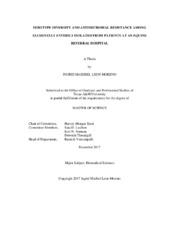| dc.description.abstract | In horses, salmonellosis is a leading cause of life threatening colitis. Researchers have identified multidrug-resistant Salmonella among serotypes commonly associated with clinical disease in horses and humans. Few published studies have utilized whole genome sequencing (WGS) to evaluate Salmonella isolates from horses, though this approach is growing in application. Our aim was to evaluate the proportional morbidity attributed to phenotypic and genotypic antimicrobial resistance (AMR) patterns and serotypes of Salmonella from patients at an equine referral hospital in the southern United States.
A total of 255 Salmonella isolates were obtained from samples submitted to a clinical microbiology laboratory arising in patients with diagnoses of salmonellosis that were admitted to the hospital between January 8, 2007 and November 4, 2015. Phenotypic antimicrobial resistance profiles were determined by the Sensititre® system. WGS was used to confirm serotypes determined according to the Kauffmann White scheme and to determine antimicrobial resistance genes. Sequencing libraries were sequenced in the Illumina MiSeq platform. Phylogenetic analyses on the main serotypes were performed in Parsnp and visualized using FigTree.
The most common serotypes were Newport (18%), Anatum (14.1%) and Braenderup (11.4%). The majority of the isolates were pansusceptible 219, 10 were resistant to less than 3 antimicrobial groups, while 25 were multi-drug resistant (>3 antimicrobial groups). The most concerning group of resistance genes were betalactamases (bla) such as blavCMY-2, blavSHV-12, blavCTX-M-27 and blavTEM-1B. The qnrB2 and aac(6')-Ib-cr genes were present in isolates with reduced susceptibility to ciprofloxacin. Additionally genes encoding resistance to gentamicin (aph(3')-Ia, aac(6')-IIc), streptomycin (strA and strB), sulfonamides (sul1), trimethoprim (dfrA), phenicol (catA), tetracyclines (tet(A) and tet(E)), and macrolides (ere(A)) were identified. The predominant replicon type was the conjugative plasmid I1 (10%) that often carries AmpC/ESBL betalactamases. Core-genome-based analyses revealed genetic associations among the strains that helped to rule in and rule out outbreaks.
The presence of AMR Salmonella in equine patients raises the risk of unsuccessful treatment and concern for potential zoonotic transmission to horse owners, attending veterinarians and hospital staff. Understanding the epidemiology of Salmonella in horses admitted to referral hospitals is important for the prevention, control, and treatment of salmonellosis in horses. | en |


